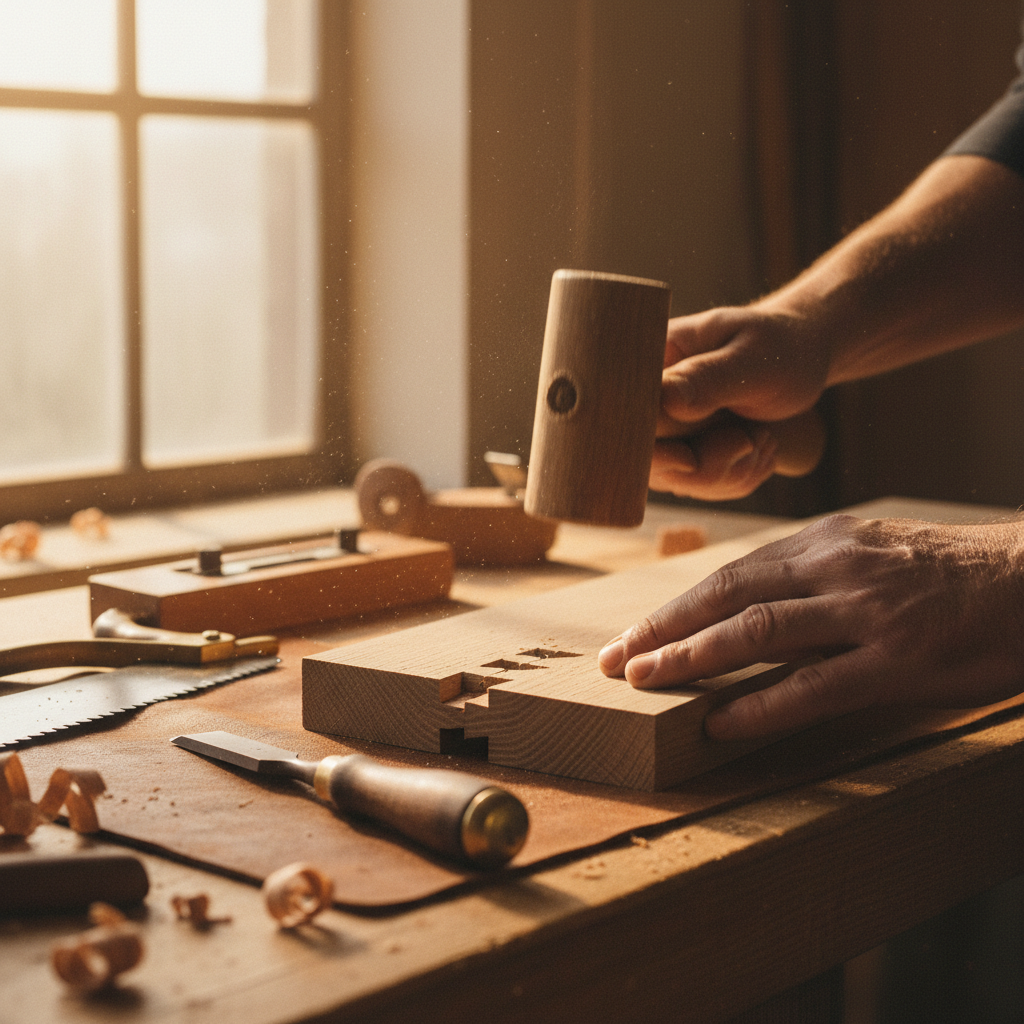Hey there, fellow woodworking enthusiast! Are you ready to dive into one of the most rewarding, and let’s be honest, sometimes intimidating, joints in all of woodworking? We’re talking about the hand-cut dovetail joint. If you’ve ever seen a beautiful piece of furniture with these interlocking marvels, you know the feeling – a mix of awe and “I wish I could do that!” Well, guess what? You absolutely can!
I remember my first attempts at dovetails. It was a messy, frustrating, and utterly exhilarating experience. My cuts were wobbly, my chiseling was hesitant, and the gaps… oh, the gaps! But with each try, something clicked. The wood started to make sense, my hands grew steadier, and the pride of seeing those pins and tails slide together for the first time was genuinely unforgettable. This isn’t just about making a strong joint; it’s about coecting with the craft, understanding wood, and developing skills that will serve you for a lifetime. So, grab a cup of coffee (or tea!), take a deep breath, and let’s demystify the hand-cut dovetail together. This guide is built on the real-world bumps and triumphs I’ve experienced, designed to give you a clear, confident path to your first perfect (or near-perfect!) dovetail.
Why Learn Hand-Cut Dovetails? More Than Just a Joint
You might be thinking, “Why bother with hand-cutting when machines can do it so much faster?” And that’s a fair question! But here’s the thing: hand-cut dovetails are more than just a method of joinery. They are:
- A Skill-Builder: They hone your sawing, chiseling, and marking precision like no other joint. It’s a foundational skill that elevates all your other woodworking.
- A Sign of Craftsmanship: Hand-cut dovetails are a hallmark of quality. They show attention to detail, patience, and a deep understanding of the material.
- Incredibly Strong: The interlocking shape resists pulling apart, making them ideal for drawers and carcass construction.
- Deeply Satisfying: There’s an immense sense of accomplishment when you slide two pieces of wood together, perfectly interlocked by your own hands. It’s a coection to the material that machines can’t replicate.
Think of it as learning to drive a stick shift. You could use an automatic, but there’s a certain control and engagement you get with a manual that’s simply different. Hand-cutting dovetails is like that for woodworking.
Tools You’ll Need (Don’t Overdo It!)
Before we start showering ourselves in sawdust, let’s talk tools. You don’t need a massive workshop or an arsenal of exotic implements. Here’s what I recommend for a begier:
- A Good Dovetail Saw: This is crucial. Look for a fine-toothed saw (around 14-20 TPI) with a thin plate and a stiff back. A Japanese pull saw or a Western-style back saw will work. My personal preference leans towards a good Japanese saw for its ease of starting cuts.
- Sharp Chisels: You’ll need a few sizes, perhaps 1/4″, 1/2″, and 3/4″ or 1″. The sharper, the better! Seriously, a dull chisel is dangerous and ineffective.
- Marking Gauge: For consistent shoulder lines. Get one with a knife-edge if possible for clearer lines.
- Dovetail Marker or Bevel Gauge: A dedicated dovetail marker (usually 1:6 or 1:8 ratio for hardwoods/softwoods respectively) makes layout easier. A sliding bevel gauge works too, but requires a bit more care in setting.
- Pencil (Sharp!) or Marking Knife: I prefer a marking knife for precision, but a very sharp pencil is a good start.
- Squaring Tool: A small engineer’s square or combination square.
- Coping Saw or Fret Saw: Great for removing waste efficiently.
- Bench Vise: Essential for holding your work securely.
- Mallet: For gently tapping chisels.
- Scrap Wood: Lots of it! This is where you’ll practice, practice, practice. Don’t use your fancy project wood first!
Don’t feel like you need to buy the most expensive tools right away. Focus on sharp chisels and a decent saw, and you’re good to go.
Understanding the Anatomy: Pins and Tails
Dovetail joints are made of two main parts:
- Tails: These are the fan-shaped parts cut into one board. They look like a dove’s tail (hence the name!).
- Pins: These are the finger-like projections cut into the second board, designed to fit perfectly into the spaces left by the tails.
The general consensus for begiers is to cut the tails first. Why? Because it’s easier to transfer the exact shape of your already-cut tails onto the pin board, ensuring a precise fit. Trying to cut the pins perfectly first and then match the tails is significantly harder.
Prepping Your Wood: The Foundation of Success
This step is often overlooked, but it’s CRITICAL. Your wood needs to be:
- Perfectly Flat: No twists, bows, or cups.
- Perfectly Square: All faces at 90 degrees to each other.
- Dimensioned Correctly: Cut to the exact size you need for your joint.
If your wood isn’t flat and square, your dovetails will never come out tight, no matter how good your sawing and chiseling. Take your time here. Use a jointer, planer, and hand plane to get it right.
Step 1: Laying Out the Tails
This is where precision begins! You’ll be working on the end grain of your “tail board.”
- Mark the Shoulder Line: Using your marking gauge, score a line around the end of your tail board. This line should be the exact thickness of your pin board. This line defines how deep your tails will go and where the shoulder of the joint will sit.
- Establish Baseline: If you’re going for through dovetails (the most common for begiers), you’ll also want to mark the waste on the end grain.
- Mark the Tails: Decide how many tails you want. For a begier, 2-3 tails are a good start on a wider board. Use your dovetail marker (or bevel gauge set to your desired angle, usually 1:6 for hardwoods, 1:8 for softwoods) to mark the angles on the end grain. Ensure the slopes are consistent. Mark the waste areas clearly with an “X” or a pencil squiggle – this helps prevent cutting the wrong part!
My tip: Don’t try to make your tails too thin or too numerous on your first try. Wider tails are more forgiving.
Step 2: Cutting the Tails (Carefully!)
This is where your dovetail saw shines. Secure your tail board vertically in your vise. Your goal is to saw precisely down your marked lines.
- Start the Cut: Rest the saw on your marked line. Use your thumb or a block of wood as a guide to start the cut cleanly on the waste side of the line.
- Saw Down to the Shoulder Line: Aim to keep the saw kerf (the width of the cut) *just* on the waste side of your line. Don’t cut into your tail! Focus on a smooth, controlled stroke. Let the saw do the work.
- Cut Both Sides: Cut all the angled lines for your tails.
It’s okay if your first cuts aren’t perfectly straight. Mine certainly weren’t! The key is to be consistent and to aim for the lines. Practice on scrap until you feel more confident.
Step 3: Chopping Out the Waste
Now that your saw cuts are done, it’s time to remove the material between the tails.
- Remove Bulk Waste with a Coping Saw: If you have a coping saw, use it to cut away the bulk of the waste, staying a millimeter or two away from your shoulder line. This makes chiseling much easier.
- Chisel to the Shoulder Line: Place your tail board horizontally in your vise, with the end grain facing up. Using your sharpest chisel, pare down to the shoulder line you marked earlier. Work from both sides (end grain and face grain) to prevent tear-out. Take small, controlled bites. You want a perfectly flat surface down to that line.
- Clean Out Corners: Use a narrower chisel to clean out the tight corners, ensuring they are crisp and square.
Don’t try to remove too much material with one chisel stroke, especially near the shoulder line. Small, controlled paring cuts are your friend here. I always say, “It’s easier to remove more wood than to put it back!”
Step 4: Transferring the Tails to the Pins
This is the magic step where your tails define the pins.
- Align the Boards: Place your cut tail board on top of your pin board. Ensure their faces are flush and the edges are perfectly aligned. You can clamp them together or hold them securely in a vise.
- Mark with a Marking Knife: Using a sharp marking knife, carefully trace around each tail onto the end grain of your pin board. This is where those crisp tail cuts pay off – they act as a perfect template. Make sure your knife is sharp, as this line will guide your saw.
- Extend Lines to Shoulder: Use your square to extend the knife lines down the end grain of the pin board to the shoulder line you previously marked (remember, the pin board’s shoulder line should be the same distance in as the tail board’s).
- Mark the Waste: Crucially, mark the waste areas on the pin board (these will be the areas *between* your marked pin lines) with an “X”. This prevents you from cutting away your pins!
This step is absolutely critical for a tight joint. Any misalignment here will translate directly into gaps.
Step 5: Cutting the Pins
Now, repeat the sawing and chiseling process, but this time on your pin board.
- Saw the Pin Lines: Secure your pin board vertically. Carefully saw down the lines you just marked with your knife, again, staying *just* on the waste side. Take your time, focus on the line.
- Chop Out the Waste: As with the tails, use a coping saw to remove most of the waste, then pare precisely to your shoulder line with sharp chisels. Work from both sides to prevent tear-out.
- Clean Corners: Ensure your pin corners are clean and sharp.
Remember, the pins are the inverse of the tails. You’re cutting away the material that *isn’t* a pin. Always double-check your waste marks!
Step 6: The Moment of Truth: Test Fitting!
This is the part where your heart might race a little. Take your tail board and slowly, carefully, try to fit it into your pin board. What usually happens on the first few tries:
- It’s Too Tight: Don’t force it! If it’s too tight, gently remove tiny slivers of wood from the *inside* faces of your pins or tails with your chisel. A light tap with a mallet might be okay, but heavy pounding will damage your joint.
- It’s Too Loose: This means you cut too much. Don’t despair! This is why practice on scrap is so important. Learn from it.
The goal is a snug fit that slides together with moderate pressure. When it’s right, it’s a beautiful thing to behold.
Troubleshooting Common Begier Mistakes
- Gaps Between Pins and Tails: Most common issue! Usually due to not cutting precisely to your lines, or the transferred lines weren’t accurate. Also, ensure your shoulder lines are consistent.
- Splintering/Tear-out: This often happens when chiseling. Use a super sharp chisel and take smaller cuts. Work from both sides (face and end grain) when paring to the shoulder line.
- Joint Doesn’t Go Together: You might have a “high spot” where a chisel cut wasn’t deep enough, or one of your pins/tails is slightly angled. Use a straight edge to check flatness.
- Uneven Shoulder Lines: This means your marking gauge wasn’t set correctly or you didn’t mark all the way around, or your chiseling wasn’t flat.
Practice Makes Perfect (Seriously!)
I can’t stress this enough. Your first dovetail will likely not be perfect. My first five weren’t! But each one teaches you something new. You’ll learn how your saw behaves, how your chisel bites, and how to read the wood. Grab some inexpensive pine or poplar and just keep practicing. The muscle memory and eye-hand coordination will develop over time, and you’ll soon be cutting dovetails with confidence and precision.
Conclusion
Learning to hand-cut dovetail joints is a journey, not a destination. It’s a challenging, yet profoundly satisfying skill that coects you to the rich history of woodworking. It will test your patience, hone your precision, and ultimately, elevate your craft. Remember those frustrating moments when your cuts were off or the joint wouldn’t quite fit? Those are the moments of learning! Each “mistake” is just feedback, helping you refine your technique for the next attempt.
Don’t be afraid to make a mess, don’t be afraid to take your time, and definitely don’t be afraid to try again. The day you slide together your first truly tight, hand-cut dovetail, you’ll feel an immense surge of pride – a coection to the material, the tools, and the centuries of artisans who came before you. So, take out your tools, prepare your wood, and embark on this wonderful woodworking adventure. You’ve got this!



